
If you’re familiar with my Instagram account, the picture component of this FODMAP friendly fried rice recipe is something you will already have seen. Numerous times in different bowls and on different backdrops. One such backdrop was a Japanese newspaper which was, as it turns out, advertising males of the night. They say all publicity is good publicity, so I feel I’ve still come out a winner.
Low FODMAP vegetarian fried rice
This is a quick and easy recipe for FODMAP friendly vegetarian fried rice. It uses lots of vegetables, grated tofu, optional egg, vegetarian oyster sauce and gluten free soy sauce or Tamari. It is low FODMAP, protein packed and uses only one pot.
On the dietary front, this FODMAP friendly vegetarian rice is FODMAP friendly, gluten free, dairy free and has an egg free/vegan option. It’s a healthy weeknight dinner that makes excellent leftovers to boot.
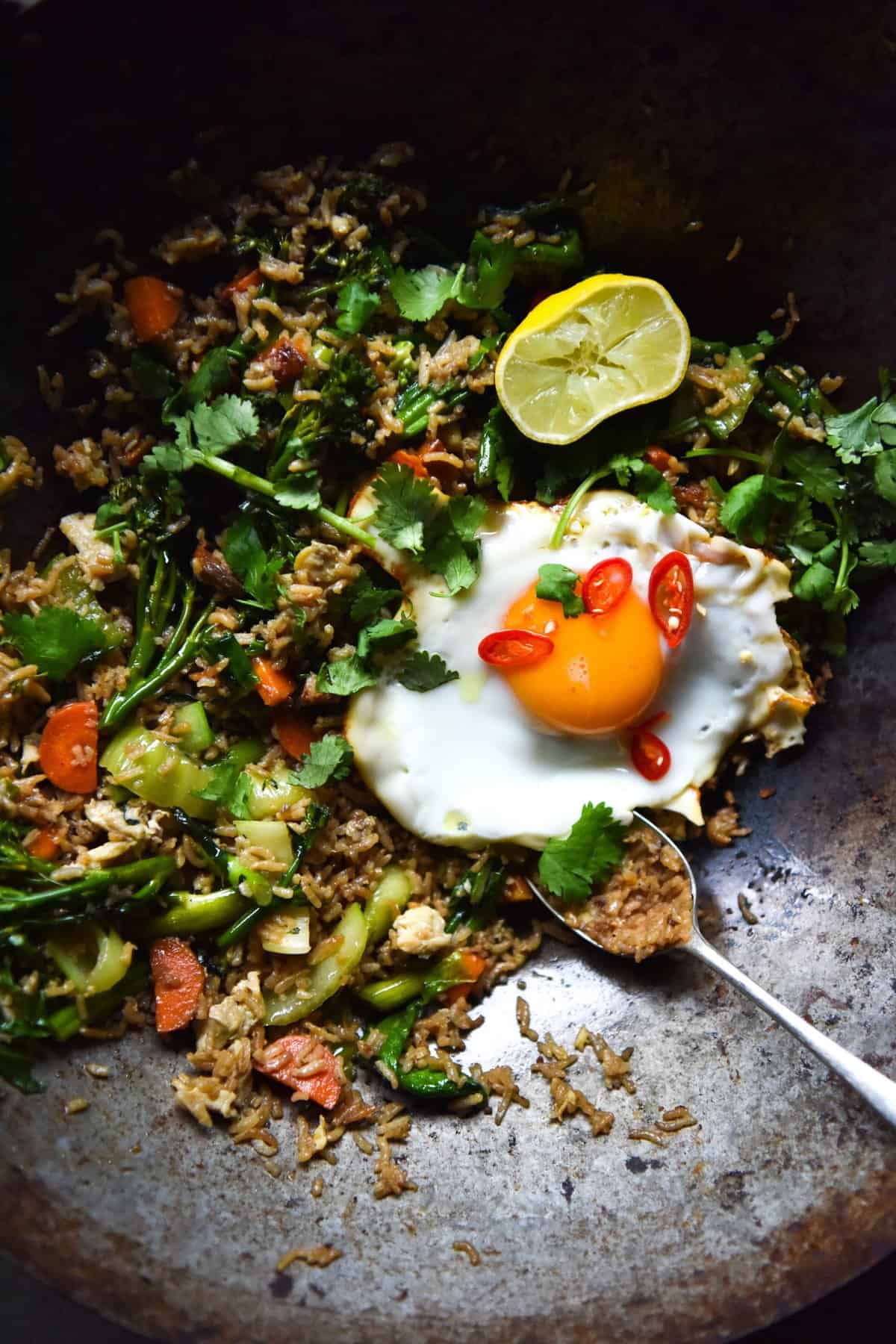
Low FODMAP vegetarian fried rice ingredient notes
Make sure you use gluten free soy sauce or tamari if the dish needs to be gluten free.
On a similar note, ensure the vegetarian oyster sauce you use is gluten free (In Australia, I used Ayam brand).
If you don’t need this to be vegetarian, feel free to add a protein of choice. If you’d like to make this vegan, use cubed tofu that has been cooked in the wok prior to starting the fried rice.
Honestly, everything I (recently aka today) have learnt about fried rice, I learnt from this Serious Eats article. Personally, I found the trick of adding a scant amount of Tamari and then fine salt to taste an absolute winner. It tastes WAY MORE LIKE FRIED RICE while still being perfectly seasoned.
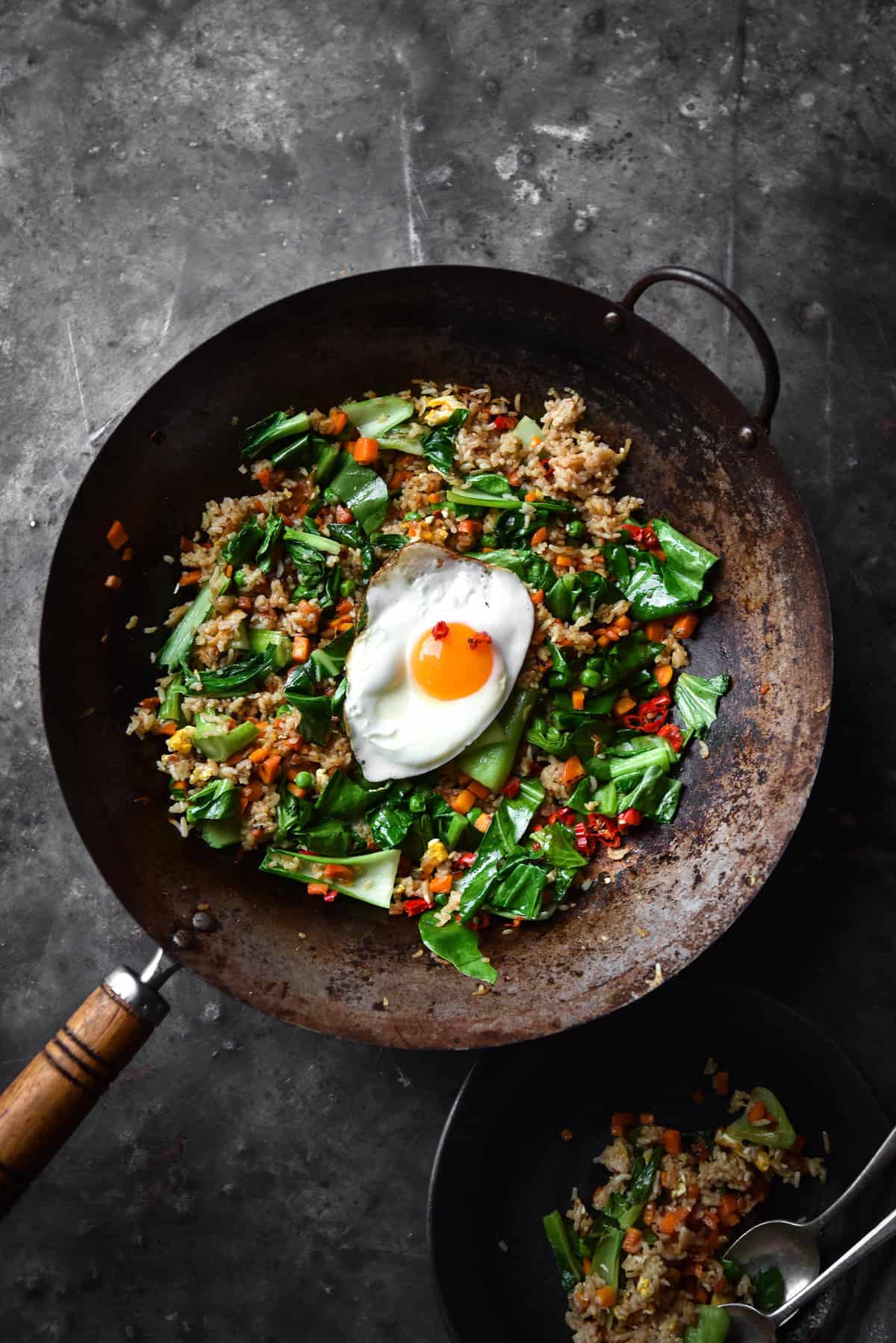
FODMAP notes
Canned corn kernels are FODMAP friendly in a 75g serving size per person. A drained canned of corn kernels weighs 240g, and this fried rice serves 6-8, so the corn content is well below FODMAP limits.
Canned peas are considered FODMAP friendly in 1/4 cup or 45g serves per person. I have used just over 1/2 cup (100g) in this recipe, so the peas are also within FODMAP limits.
Firm tofu is FODMAP friendly in 160g serves per person and we’re using 400-500g for this stir fry.
Oyster sauce is listed on the Monash app as being an oligos-fructans issue in 40g (2 tablespoon) volumes. I’m not sure if this is only for regular as opposed to vegetarian. Either way, we are using 5 tablespoons between 6-8 serves. If the fried rice serves 6, each serve should have approximately 16.6g of oyster sauce.
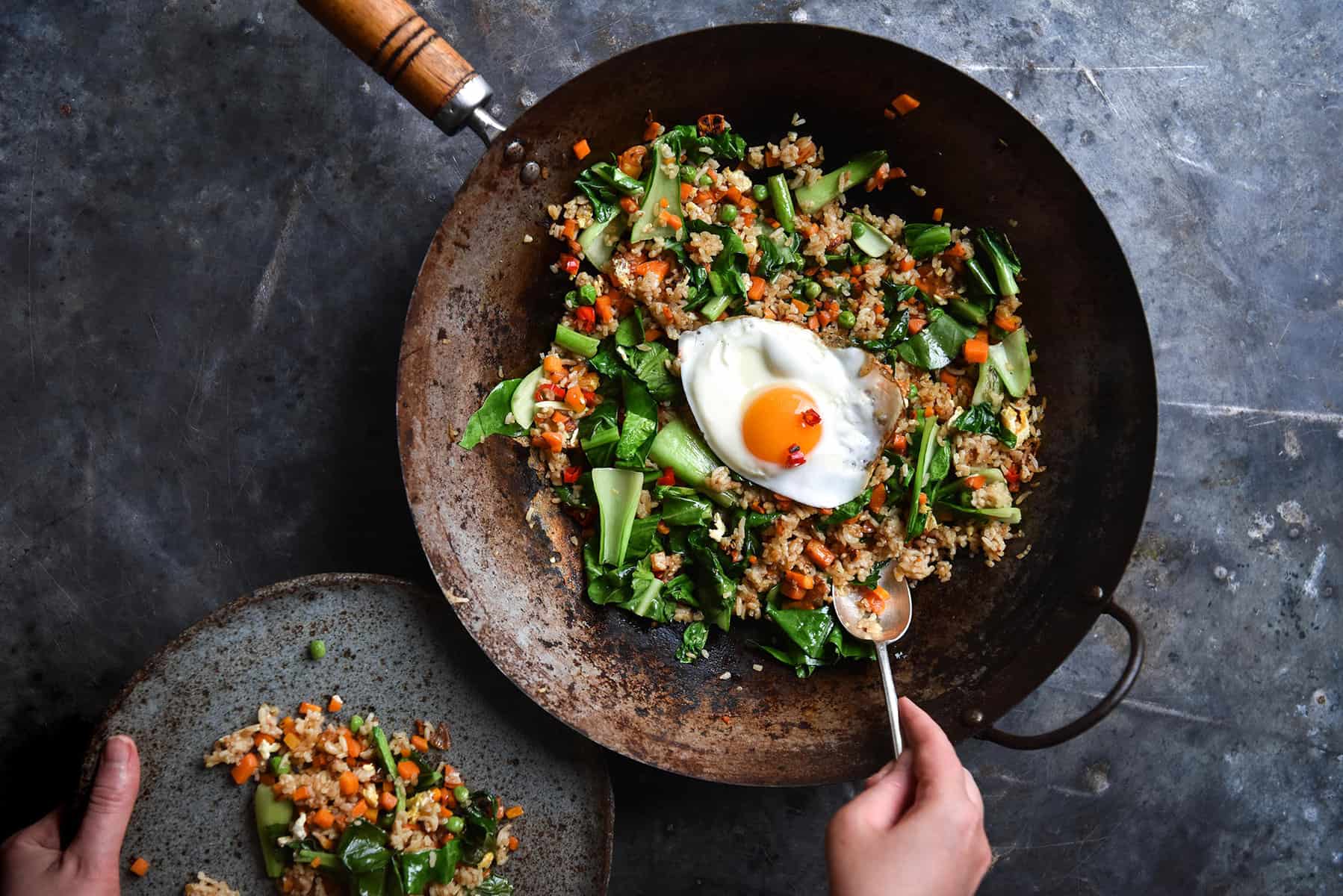
Substitution options
You can add or omit ingredients depending on what works for you. If you can’t have peas, omit them! If you have a vegetable you like in fried rice, add it!
Keep in mind that if the volume of vegetables you add is less than the recipe card, you will need to add less oyster sauce and soy sauce to compensate.
I love adding carrot and Asian greens because they’re appropriate and low FODMAP.
If you don’t need this vegetarian fried rice to be gluten free, you can use regular soy sauce.
I quite like serving this fried rice with a fried egg. It’s optional, but it adds
Tips for great fried rice
I’m not a fried rice expert, but these are the tips and tricks I have learnt from my humble forays into the making of the delicacy.
Don’t use ‘wet’ rice. As the Serious Eats article says, anything with some moisture to it will add moisture to the end product. You can use rice you’ve cooked recently, (although a lot of people suggest to use old rice) but make sure it has dried out first.
To that end, once your rice has cooled enough to handle, lay it out on a lined baking sheet to dry out a little. I keep mine in the fridge for a couple of hours.
Ideally, use a wok and a gas burner. Again to quote the Serious Eats Article, use a flat pan and work in batches if you have an electric stovetop – you need flames to be going up the edges of a wok for it to be an effective cooking tool.
Cook your hard vegetables first, your other vegetables second and your rice last. Too much stirring will break up the grains.
Add only just enough Tamari to very very lightly colour the rice. Then, use a fine salt to season it to perfection. This is probably my most important tip to getting that fried rice flavour.
Move the rice around the the pan continually and allow some grains to get a little crispy.
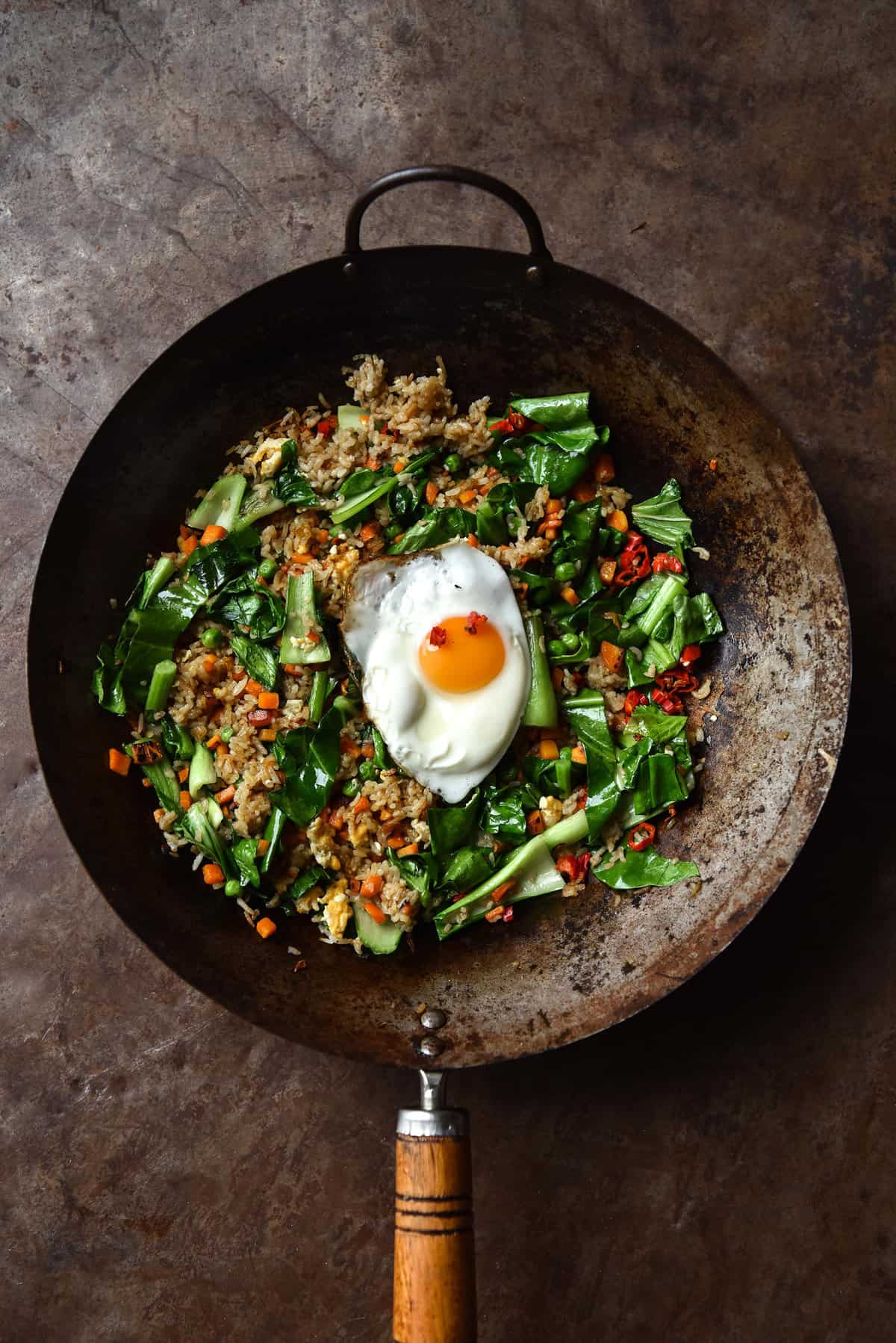
More low FODMAP vegetarian recipes
- Low FODMAP vegetarian or vegan Pad Thai
- Low FODMAP Thai red curry
- Sweet and sticky ginger tofu
- Gluten free vegan dumpling wrappers
- Low FODMAP vegan Thai larb
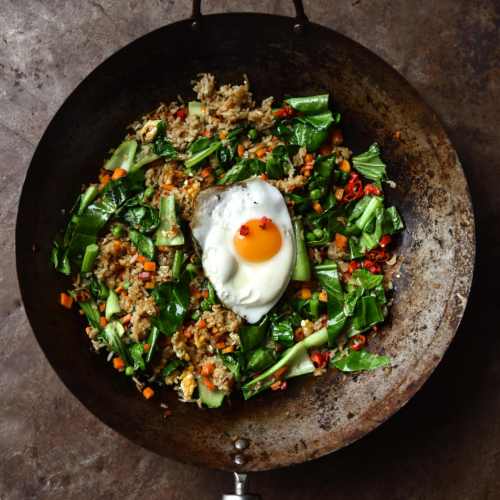
Low FODMAP vegetarian fried rice
Ingredients
For the fried rice
- 1 cup (200g) white rice
- 3 tablespoons vegetable oil
- 1 bunch spring onion greens, chopped
- 30-50 g freshly grated ginger
- 1/2 small broccoli, finely chopped (optional
- 2 medium carrots, finely cubed
- 1 bunch bok choi
- 1 bunch pak choi
- 1/4 – 1/2 canned peas (optional)
- 1/3 cup canned corn (optional)
- 400-500g firm tofu, grated
- 1/4 – 1/3 cup (125-185ml) vegetarian oyster sauce
- 2 tablespoons Tamari or gluten free dark soy sauce
OPTIONALS:
- Fresh red chilli
- Toasted vegetable oil, to taste
Instructions
- Fill a large pot with water, and then bring it to the boil. Once boiling, add your rice, and continue to cook, turning down the heat slightly until the rice is done. You can use the absorption method if you desire, but I tend to fuse my pot and rice together whenever I try.
- Once the rice has cooled enough to handle, lay it out on a baking sheet to dry out a bit. Break up any clumps with your hands.
- Add a splash of oil to a wok or pan (see notes) over a super high heat. Add 1-2 tablespoons of peanut oil, and fry your carrot until golden and crispy. If you're using any other hard vegetables, add them here.
- Add a splash more of peanut oil and the grated ginger. You can add a teaspoon of sugar here if you fancy. Once it is fragrant, add the rice and use a spatula to keep it moving over the high heat.
- Add the tamari – just enough to lightly colour the rice. Add a pinch of fine salt, and adjust for taste (remembering there will be added vegetables.) Add the vegetables in, one variety at a time, stirring continuously as you work.
- If you're using eggs, move the fried rice to the side of the wok and add a dash of extra oil. Crack the egg into the middle of the wok (without getting too much rice in it) and use the spatula or a fork to roughly scramble the egg. Move it around the wok until it begins to set up, then use the spatula to break it into small pieces and stir it through the rice. You can also add an egg on top, if you'd prefer (I do both!)
- Serve with some red chilli and condiments of choice. Can be frozen, but take care to reheat it adequately.


Your pics are gorgeous, can’t wait to try the rice!
Thank you Kasey! I hope you enjoy it 🙂